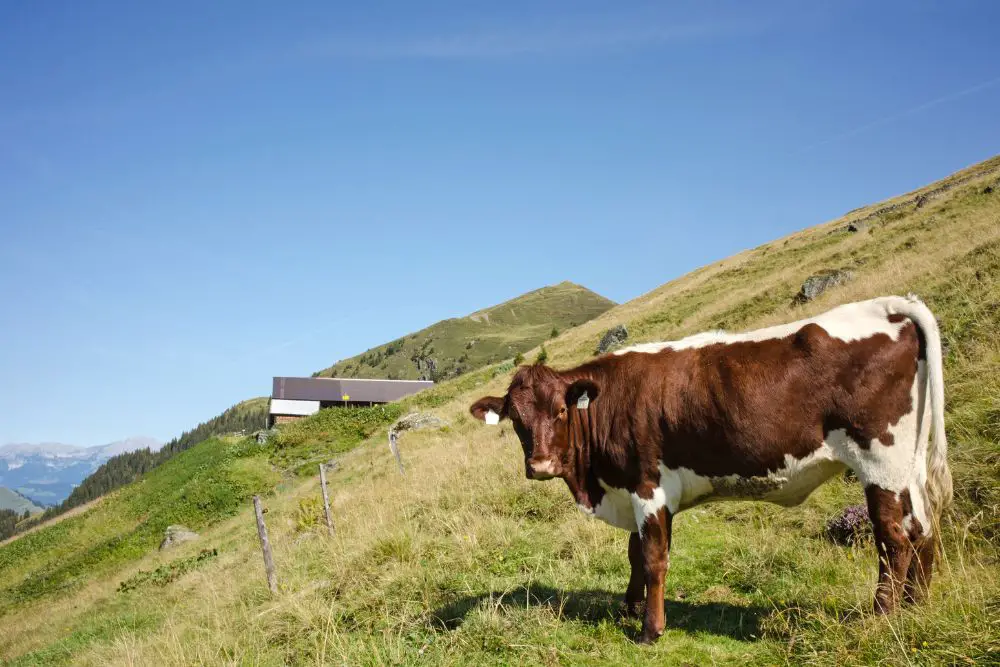Pinzgauer cattle are primarily used for milk and beef production. Originally from Austria, this breed has proven its adaptability, mothering ability, hardiness, and meat quality.
Pinzgauer cattle have been exported to countries throughout Europe, South Africa, and North America.
Table of Contents
Where Does The Pinzgauer Come From?
Pinzgauer Cattle are named after the Pinzgau region in the Austrian state of Salzburg where the Pinzgauer breed originated.
Valley areas within Tyrol, Bavaria and Styria had high populations of purebred Pinzgauer cattle and they evolved to be one of the hardiest Alpine breeds of cattle in Europe, offering both high milk yields, and excellent quality meat.
They were the most common horned beef cattle breed in Austria in the 17th and 18th centuries, and in the early 1800s, Pinzgauers were exported to what is present-day Romania and the surrounding territories.
In 1856 they were shown in Paris at the World Exposition and were shown at the same exposition in Vienna in 1873 where international interest grew in the breed.
The first breeders association for Pinzgauer’s was founded in the 19th century and a herd book was created for them which dictated ideal traits, favoring the chestnut color and horns. This resulted in the black Pinzgauer color being bred out of them, and the naturally polled variety becoming increasingly rare.
In the early 1900’s a large purebred herd of Pinzgauer’s was exported to South Africa. Today, they have the second largest population of Pinzgauer bulls in the world.
Pinzgauer cattle were first brought to Canada in 1972 and were imported into the United States in 1974. The American Pinzgauer Association was then founded, and breeders have been tasked with keeping the high breed standards that Pinzgauer cattle are known for.
Unfortunately, the population of Pinzgauer cattle has been steadily declining, and they are listed as endangered. Crossbreeding and upbreeding programs have been introduced in several countries to bolster their numbers.
Pinzgauer Cattle Breed Characteristics
| Official Breed Name | Pinzgauer Cattle |
| Scientific Name | Bos primigenius |
| Origin | Austria |
| Appearance | Finched pattern with rich chestnut brown sides, with white stripe back, belly, udder, tail and head. |
| Calf Weight | 70lbs to 80lbs |
| Mature Cow Weight | 1300lbs to 1500lbs |
| Mature Cow Height | 4.4 feet |
| Mature Bull Weight | 2200lbs to 2400lbs |
| Mature Bull Height | 4.7 feet |
| Ready To Breed | 12 months |
| Gestation Period | 9 months |
| First Calvings | 21 months |
| Time to Slaughter | 6 to 9 months, but 12 months is better |
| Carcass Weight | 760lbs |
| Expected Lifespan | 20 years |
| Productive Lifespan | 7+ years |
| Known For | Meat quality, high fat milk, hardiness, vigor, feed efficiency and adaptability |
| Weaknesses | Does not handle hot summers |
| Climate | Raised as an alpine breed, but does well in a variety of mild climates |

What Is So Special About Pinzgauer Cattle?
1. Milk Quality and Yield
Pinzgauer cows offer a high-milk yield of 11,800lbs annually that contains 3.89 percent fat, and has 3.28 percent protein.
Cows continue to produce calves and are great milkers until they are 12 to 16 years old.
Pinzgauer’s also have above average weaning weight of calves (600lbs average).
2. Meat Quality
Data obtained from the USDA Meat Animal Research Center shows steers with Pinzgauer breeding have:
- 61% Choice over 69% Retail Product
- Ribeye Area = 11.28 square inches
- Shear Force test was 4.47kg
The shear force test proved Pinzgauer’s have the most tender meat out of all Angus breeds with most of them having a rating over 5kg. This tenderness is achieved without chemical processing.
Additionally, the meat of Pinzgauer cattle has a rich red color with a natural marbling effect, making it desirable for the market.
Why Should I Raise Pinzgauer Cattle On My Farm?
- Adaptability and proven vigor in different climates
- A polled subtype of Pinzgauer cattle exists called the Jochberger Hummeln for those seeking a polled variety of Pinzgauer
- Rarely suffer from insect infestations due to their flexible skin that is smooth
- They almost never have eye problems
- Natural skin pigmentation protects against sun damage
- Reach maturity at a young age in comparison with other beef breeds
- Offer above-average fertility and calf survival rates
- Pinzgauer cows have a high butterfat percentage in their milk
- Pinzgauer steers are fast-growing and profitable
According to the American Pinzgauer Association, many animal scientists claim Pinzgauers should be used as the standard for genetic purity of beef cattle
